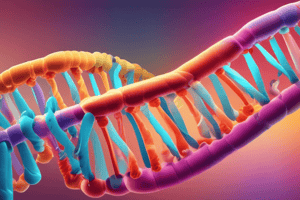Podcast
Questions and Answers
Which molecule is responsible for storing genetic information?
Which molecule is responsible for storing genetic information?
- Polypeptide
- tRNA
- RNA
- DNA (correct)
What is the role of the ribosome in translation?
What is the role of the ribosome in translation?
- Termination
- Elongation
- Peptide Bond Formation (correct)
- Initiation
What is the first step of transcription?
What is the first step of transcription?
- Elongation
- Termination
- Peptide Bond Formation
- Initiation (correct)
What is the final step of transcription?
What is the final step of transcription?
Which process ensures the transmission of genetic information?
Which process ensures the transmission of genetic information?
Flashcards are hidden until you start studying
Study Notes
DNA and RNA: The Blueprint of Life
Deoxyribonucleic acid (DNA) and ribonucleic acid (RNA) are nucleic acids that play crucial roles in the functioning of all known living organisms. DNA is the genetic material present in the chromosomes of the cell nucleus and in the mitochondria, while RNA is a type of nucleic acid that is present in the cytoplasm of the cell. Both DNA and RNA are essential for the transmission of genetic information and the expression of genetic traits.
Structure
The structure of DNA can be described as a double helix, with two complementary strands of nucleotides coiled together. The DNA molecule is too large to fit into the nucleus of the cell, so it is coiled around histones to form chromatin. Chromatin is then condensed into chromosomes during cell division.
RNA, on the other hand, is a single-stranded nucleic acid with a structure similar to DNA, but with a sugar molecule called ribose instead of deoxyribose. RNA molecules can vary in length, from small transfer RNA (tRNA) molecules to long messenger RNA (mRNA) molecules.
Replication
DNA replication is the process by which DNA is copied, allowing the genetic material to be passed from one generation of cells to the next. The DNA molecule is first unwound, and two complementary strands are formed, each with its own base sequence. The new strands are then synthesized, with each nucleotide being added to the growing strand based on its complementary base pair with the existing strand. This process ensures that each new cell receives an exact copy of the genetic material.
Transcription
Transcription is the process by which the genetic information in DNA is used to create RNA molecules. This involves the following steps:
- Initiation: The enzyme RNA polymerase binds to the DNA molecule at the start site of the gene to be transcribed.
- Elongation: The enzyme moves along the DNA, synthesizing the RNA molecule.
- Termination: The enzyme reaches the end of the gene and stops transcribing, releasing the newly synthesized RNA molecule.
Translation
Translation is the process by which the genetic information in RNA is used to produce proteins. This involves the following steps:
- Initiation: The RNA molecule binds to a small subunit of the ribosome, which is a complex of proteins that plays a crucial role in protein synthesis.
- Binding of the Aminoacyl-tRNA: A transfer RNA (tRNA) molecule binds to the ribosome, bringing with it an amino acid that will become a part of the growing polypeptide chain.
- Peptide Bond Formation: The ribosome catalyzes the formation of a peptide bond between the amino acid on the tRNA and the growing polypeptide chain, extending the chain by one amino acid.
- Recycling of tRNA: The tRNA is released from the ribosome and can participate in a new round of translation.
In summary, DNA and RNA are essential molecules that play crucial roles in the functioning of living organisms. DNA stores the genetic information, while RNA is responsible for its expression. DNA replication ensures the transmission of genetic information, and transcription and translation are the processes by which the genetic information is used to produce proteins.
Studying That Suits You
Use AI to generate personalized quizzes and flashcards to suit your learning preferences.




